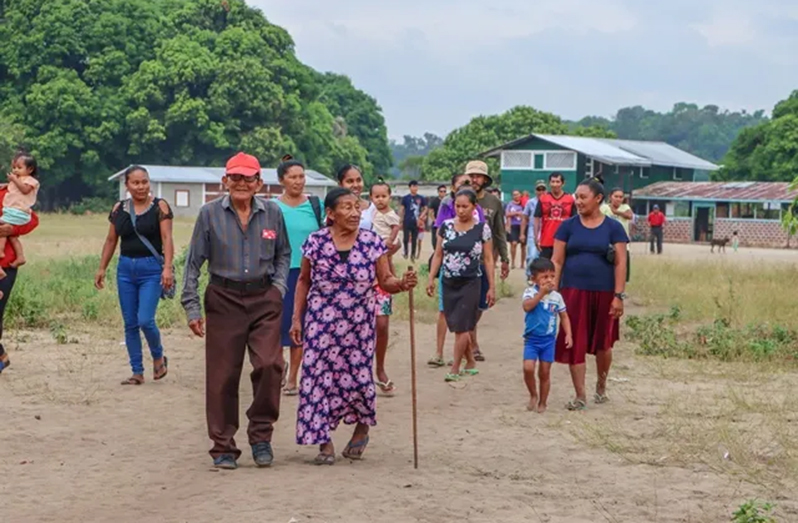THE Government of Guyana is resolutely advancing with the implementation of the national carbon credit credits programme under the Low Carbon Development Strategy (LCDS) 2030. This includes the implementation of low carbon projects at the village level in Amerindian villages across all regions of Guyana. The Amerindian Village of Apoteri in Region Nine is demonstrating rapid progress in its implementation efforts.
Minister of Natural Resources Vickram Bharrat, who visited the community last month, was provided an update by the village on progress on low-carbon projects, and Minister Bharrat gave a detailed overview of the government’s goals for national development during his visit.
According to the Minister of Natural Resources, “This is the first payment. Next year, there will be another payment, and your village will receive continuous, predictable financing to sustain low-carbon development projects. This will still not be the end because you will be benefitting from this programme at least for a period of 10 years.”
Noting that these payments are not a substitute for other resources, the Minister also mentioned that the 242 Amerindian villages have already benefitted from them and are implementing many projects on social upliftment, economic ventures, and food security.
He also urged the village of Toshao to optimise using the funds on low-carbon economic business ventures that will generate income in the community for all villagers.

He explained, “This money is going to be added to what you are already receiving. Like the presidential grant, the capital grant, money from the budget, and other programmes that have been implemented by the government to support you financially.”
Minister Bharrat expects Guyana to undergo a significant transformation through government investments. “The future ahead of us is a bright one. Ten years from today, Guyana, including the village of Apoteri and other villages, will not be the same. We will all be experiencing major success,” he stated.
The Toshao of the village, Ozias James, also expressed his appreciation to the government on behalf of the people of Apoteri and recognised the importance of low-carbon investments at the village level at a time when many climate-related impacts are affecting villages.
In one of his press conferences earlier this year, the Vice President of Guyana, Dr. Bharrat Jagdeo, related that the village councils in the Amerindian communities are actively working on several developmental projects that are supported by funds from the national carbon credits programme.
According to Dr. Jagdeo, Guyana received a payment of US$22 million, which represents 15 per cent of carbon credits totalling GYD$4.7 billion, that is being disbursed towards economic development and the upliftment of the Amerindian population.
The Vice President explained, “We anticipate that by the end of the year, most of it will be expended. If you listen to the Toshaos, you will hear about how transformative these funds have been in their communities; apart from the support that they have received directly from the government through tractors and all of that, these funds alone have made a huge impact in these villages.”
At the 2023 National Toshaos Council (NTC) Conference, Toshaos presented transformative projects that are ongoing in their villages, including in agriculture, eco-tourism, infrastructure, and income-making projects for vulnerable groupings, among others.

“Next year, these communities will get another $2.6 billion because we will receive $87 million. This will go up to 2030; every year they will get these funds, and this is only for 30 per cent,” Dr. Jagdeo added.
When the remaining 70 per cent of carbon credits are sold, there would be significant additional resources available for villages and communities across Guyana. While 15 per cent of carbon credit revenues are going directly to Amerindian villages, the remaining 85 per cent is also invested in projects that benefit communities all across Guyana at the national and regional levels.
Although the government-conceptualised initiative has resulted in significant benefits to Amerindian villages, Dr. Jagdeo highlighted that a Georgetown-based Non-Governmental organisation has attempted to block the funding by writing the Architecture for REDD+ Transactions (ART) Secretariat, but there has been no support by villages to block crediting or funding that can come to them.
Vice President Jagdeo also reminded us that “in 2009, when we launched the first Low Carbon Development Strategy and when the Guyana Norway Agreement was implemented, the APA tried to block the funds coming to Guyana and, by extension, Amerindian villages.”
Importantly, based on detailed consultation reports published on the LCDS website, there has been well-documented reporting of detailed stakeholder engagement across Guyana. The LCDS 2030 and the carbon credits programme continue to make a transformational impact in villages like Apoteri in Region Nine and villages all across Guyana.
(This is part of a weekly series on the LCDS.) The author can be contacted at cparkinson0206@gmail.com.



.jpg)








